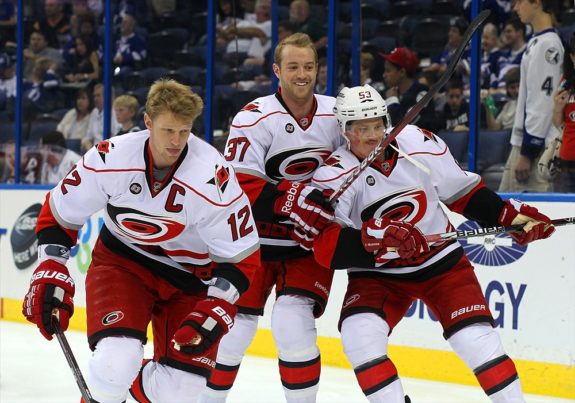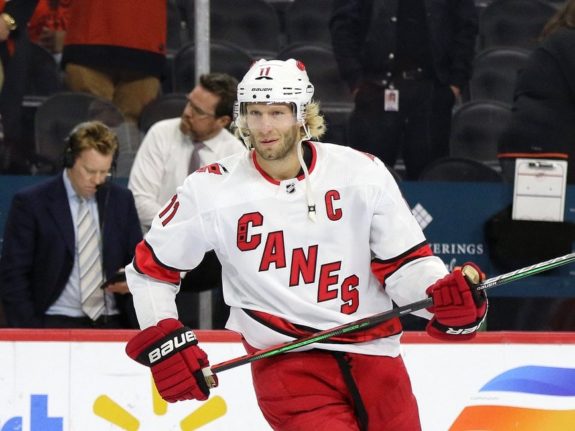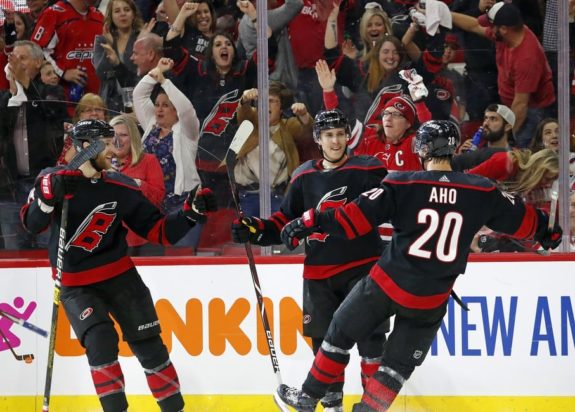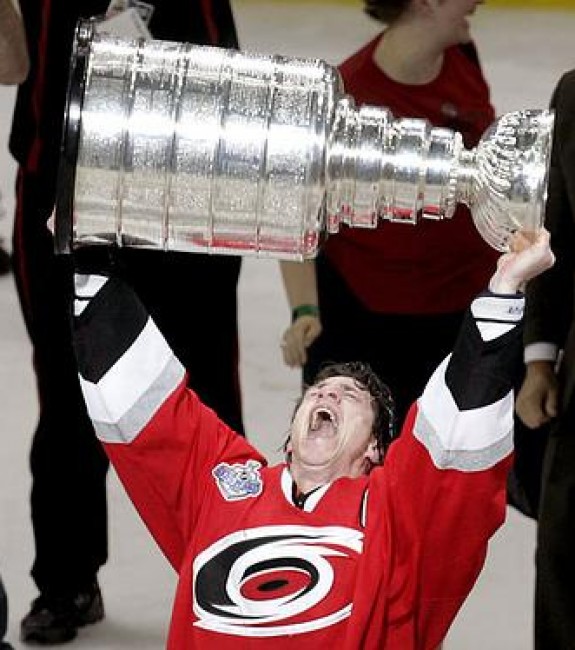Since relocating from Hartford in 1997, there have been some special seasons in Carolina Hurricanes history. The team has had its fair share of hard times, to be sure. However, when the team is good, they seem to be really good. Between 2001 and 2009, the Hurricanes made the postseason just three times, but once they got in, they proved hard to beat. The team made the Conference Final in 2002 and 2009 and won the Stanley Cup in 2006.
Alongside that team success, the franchise has seen its fair share of star players come to town over the years that made their mark in growing the game in the area. So, today, let’s take a peek at the five best individual seasons in the history of the Carolina Hurricanes. These are some of the players that inspired a generation of hockey players in North Carolina, whose jerseys you’ll still see at PNC Arena during any given home game.
Production obviously plays a huge role in a list like this, but equally important here is the team success it led to. That’s why you won’t see Justin Faulk or Jeff Skinner make the list; despite great accomplishments in their time here while being bright spots on bad teams, their production was pretty hollow. In that vein, you can probably deduce which is the only season to earn two players on the list. Playoff performance was also taken into consideration.
Also, this list is purely since relocation, so apologies to Mark Howe, Pat Verbeek, Geoff Sanderson, and Kevin Dineen.
Honorable Mentions
Eric Staal, Cam Ward and Jeff Skinner, 2010-11: All three of these seasons were actually quite good, and maybe we would be talking about them if the Hurricanes hadn’t gotten trounced 6-2 in the win-and-get-in season finale against the Tampa Bay Lightning. E. Staal scored 33 goals, and at just under a point-per-game pace, Skinner scored 32 as an 18-year-old rookie en route to the Calder Trophy. Cam Ward had a stellar .923 save percentage, the best mark in franchise history — Hartford or Carolina (min. 35 games played, so a true starter workload). The future looked bright for the team after this season, but unfortunately that promise never materialized for this core. I maintain this season was Skinner’s best in the NHL, probably even including the year he scored 40 in Buffalo; surely his concussions played a huge role in that.

Dougie Hamilton, 2019-20: Hamilton was working on the best season of his career before getting tied up with Columbus’ Kevin Stenlund and fracturing his fibula. He was probably the Norris Trophy frontrunner and had already potted 14 goals and 40 points in just 47 games. It sort of makes a Hurricanes fan wonder how things may have been different had it not happened, as Hamilton seemed to lose a touch of mobility after the injury and subsequent surgery — and mobility was never really his strength to begin with. He definitely didn’t look as dominant this past season, especially in his own end. Maybe the Hurricanes would have tried harder to keep him around? We’ll never know.
Sebastian Aho, 2019-20: Similarly to Hamilton above, the pandemic robbed Aho of what was sure to be a 40-goal season, and if he got hot or had a couple of multi-goal games, perhaps he even could have pushed for 50. 12 goals in 16 games is a lot, but it’s not like it’s outside the realm of Aho’s capabilities. At the very least, he probably could have eclipsed Staal’s since-relocation record of 45 goals.
Jaccob Slavin, 2019-20: I couldn’t bring myself to put a defenseman over any of the actual top five, but Slavin likely would have been it had I found a good excuse to take someone out. I don’t think this particular season was a huge step up in his game from the previous couple of seasons, but, rather, this is when he began to shake the “underrated” label. There’s a difference between performing as the underdog and when the opposition is keying on you every night, and Slavin continued to showcase his dominance en route to a fifth-place finish in the Norris voting — particularly impressive considering his six-goal, 36-point season is far from the type of gaudy numbers you expect to see from a top candidate for the award.
Number 5: Jordan Staal, 2020-21
Numbers: 16 goals, 22 assists in 52 regular-season games; five goals, three assists in 11 playoff games
Kicking off the (actual) list, I couldn’t bring myself to not include the monstrous season the captain just had. In a year where Andrei Svechnikov really struggled, and Teuvo Teravainen was limited to just 21 games, Jordan Staal stepped his game up to monstrous heights in both ends. The numbers aren’t anything crazy, but when you factor in the other areas of the game in which he’s always dominant, it adds up to one of the best seasons the franchise has ever seen.

Staal won 58 percent of his faceoffs, played over 18 minutes a night in all situations, and registered a team-leading 135 hits. He had a 53.1 percent Corsi for percentage (CF%) despite starting 53.7 percent of his shifts in the defensive zone (per Natural Stat Trick). In the postseason, he stepped up with big plays time and again, too, including scoring twice in the series opener against Nashville and the overtime game-winner in a pivotal Game 5 with the series knotted at 2.
Despite being known as a defensive specialist, Staal’s 2.3 points-per-60 (pts/60) was the best mark of his career since his age-23 season, when he scored 25 goals and 50 points in 62 games with the Pittsburgh Penguins. It’s probably unfair to expect him to replicate that kind of production moving forward, but if the Hurricanes were to continue getting that sort of production out of him to lengthen their lineup, they’ll be extremely difficult to handle. But even if he doesn’t continue to show up on the scoresheet like this, the team knows they’re going to get a significant level of production out of their captain.
Number 4: Aho and Teuvo Teravainen, 2018-19
Numbers: Aho – 30 goals, 53 assists in 82 games; five goals, seven assists in 15 playoff games, 10th in Hart Trophy voting; NHL All-Star Team
Teravainen – 21 goals, 55 assists in 82 games; seven goals, three assists in 15 playoff games

It’s just about impossible to separate “The Cherubs,” the linemates and countrymen, so we’re just going to cheat a little bit on this one. The 2018-19 season was an extremely memorable one for Hurricanes fans, as it was the season the decade-long playoff drought finally came to an end. The two Finnish stars were right at the middle of it, anchoring the first line and putting forth huge seasons to propel the team into the playoffs for the first time since 2008-09.
Despite promising seasons prior, Aho and Teravainen simultaneously broke out and entered the echelon of true stardom during this season. They both played in all situations, killing penalties at an extremely high level while cementing themselves as true first-line point producers. Aho became just the sixth Hurricanes player to finish the season at a point-per-game, and first since the lockout-shortened 2012-13 season when Alexander Semin and Eric Staal accomplished the feat.
In the postseason, the duo continued to play leading roles in riveting series wins over the Washington Capitals and New York Islanders, showcasing they aren’t just regular-season performers. They would run out of gas and somewhat disappear in the Conference Final, much like the rest of the team, but for young forwards facing a veteran Boston Bruins squad deep in the postseason, that was understandable (and probably expected).
This year re-created the buzz around hockey in North Carolina, and without Aho and Teravainen, it never would have culminated (shoutout to Justin Williams in this regard, too). The two Finnish studs are primed to continue spearheading the top of the lineup for the foreseeable future.
Number 3: Ron Francis, 2001-02
Stats: 27 goals, 50 assists in 80 games; six goals, 10 assists in 23 playoff games; won Lady Byng, won King Clancy, finished sixth in Hart Trophy voting; NHL All-Star Team
The 1998 free agent signing of Francis signaled a huge win for the young Hurricanes franchise, as entering just their second year in North Carolina, they were able to add a marquee name to the roster. While Francis was 35 years old, he was still coming off an 87-point campaign with Pittsburgh when he cashed in on a four-year deal to return to the organization that drafted him nearly two decades earlier. He would never quite re-capture the big numbers he was accustomed to with Pittsburgh and his early days in the Carolina organization (then-Hartford, obviously). However, the 2001-02 season was the closest he would come, and it provided the validation both he and the franchise needed.
The 2000-01 team would qualify for the playoffs, but the infamous Scott Stevens rampage in the first round against New Jersey all but sealed their fate right off the bat. Stevens knocked Francis, as well as rookie Shane Willis, from the series with thunderous hits. They would get their revenge the next season, taking down the Devils in the opening round, before the Montreal Canadiens and Toronto Maple Leafs received the same fate — all in six games. The Hurricanes would, unfortunately, fall in the Stanley Cup Final to the juggernaut Detroit Red Wings. However, the goal he scored in overtime to steal Game 1 in Detroit will forever live on in Hurricanes lore (shoutout to the legendary Bob Cole on the call), as it gave the Hurricanes their only win of the series.
Despite not being in the same tier as Detroit, this was the season that put the Carolina Hurricanes on the map, led by an all-timer in Francis. Now 38, he would receive significant postseason recognition from the league in the awards voting. In the next couple of years, he would see his game begin to slow down before ultimately heading to Toronto for one final season in 2003-04.
You can’t really examine the early-year Hurricanes without mentioning Francis, and this season easily stands out as his most accomplished. Without his big season and the subsequent postseason success, the next two players may never have brought the legendary seasons they did to Raleigh.
Number 2: Rod Brind’Amour, 2005-06
Stats: 31 goals, 39 assists in 78 regular-season games; 12 goals, six assists in 25 games; won Selke Award
And, now, as you probably could have guessed, we get to the final two players — teammates during the magical run that was the 2005-06 season. The Hurricanes, predicted before the season to finish near the bottom of the Southeast Division and overall standings, roared to a 52-22-8 record, setting a franchise record with 112 points before rolling to a Stanley Cup victory. There are a lot of different players who deserved consideration from this team — Ray Whitney, one of the most underrated Hurricanes ever; Cory Stillman, who also could probably fall under that distinction; Justin Williams, as clutch as ever during the postseason run; perhaps even Frank Kaberle, a blue line staple who had a career year. However, the next two were incredibly easy calls, as the star youngster and the captain and leader of the locker room take the cake.

The number five ranking above, Jordan Staal, was basically a lite-version of what Brind’Amour put forth in this storybook season. One of the NHL’s most respected two-way forces the entirety of his career, he was certainly no slouch in the offensive end, and this season wasn’t really a huge deferral from his norm, either. In fact, Brind’Amour actually scored more points the following season, during which the Hurricanes missed the playoffs. However, this season in particular, beautifully represented just how Brind’Amour earned the respect he had throughout his career. Each time it seemed like the Hurricanes were down and out, he seemed to be in the middle of the turnaround.
In the postseason, when the Hurricanes faced a 2-0 deficit headed to Montreal for Games 3 and 4, it was Brind’Amour stepping up in both games to ensure the Hurricanes never even faced an elimination game. In Game 3, the Hurricanes trailed 1-0 in the third period when Brind’Amour scored to send it to overtime, where the next player on the list ended it. In Game 4, Brind’Amour broke the third-period tie, a game-winning goal to send the series back to Raleigh deadlocked at 2. The rest of that series — and postseason run, as a whole — went near-flawlessly. Brind’Amour led the team in goals in three of the four series in the postseason, with the lone series he didn’t lead the team being the five-game beatdown the team handed the New Jersey Devils in the Conference Semifinal. It was truly just an all-around stupendous season from no. 17, a consistent source of offense and elite shutdown centerman that was difficult to play against night in and out.
The now-head coach is a legendary figure in Hurricanes history, and this season played a huge role in that. His incredible coaching exploits, alongside the struggles he had at times at the end of his career, can sometimes make it easy to forget just how dominant Brind’Amour was during his prime. The 2006 Stanley Cup was a heck of a feather in his cap.
Number 1: Eric Staal, 2005-06
Stats: 45 goals, 55 assists in 82 games; nine goals, 19 assists in 25 playoff games; NHL All-Star Team; 4th in Hart Trophy voting
Ridiculous regular season, check. Most points in Hurricanes history, the only century mark hit since relocation, check. Overpowering playoff run, check. Stanley Cup, check. The best season in Carolina Hurricanes history is a pretty easy call, as Staal put on a show during the 107 games played (including the postseason). Eric was able to bring the team all the way to the peak, and in the most memorable Hurricanes season to date, was able to put forth a season unmatched since.
The second overall pick in the 2003 NHL Entry Draft, Staal immediately jumped into the NHL at 18. He posted a solid, albeit unremarkable, season in 2003-04, then the lockout wiped out the 2004-05 season, during which he laid waste to the American Hockey League. He returned with a vengeance as a baby-faced 21-year-old, scoring a Hurricanes record 45 goals and looking like the next superstar in the league, right alongside the likes of Sidney Crosby and Alexander Ovechkin.
Staal was obviously imperative in the Hurricanes’ postseason run, pacing the team with 28 points and, like Brind’Amour, coming up with numerous timely contributions. Facing the aforementioned 0-2 deficit in round one, it was Staal who got the Hurricanes on the board in the series with the Game 3 overtime winner.
It’s somewhat depressing to consider what could have been if he wasn’t consistently playing with the Chad LaRoses and Jiri Tlustys of the hockey world. And, ideally, not only had a little support on his line but throughout the roster so that he wouldn’t be the only scoring threat the opposition had to gameplan for. Still, while he never reached the aforementioned heights of being on the same level as players like Crosby and Ovechkin, he’s still probably the best Hurricane ever when you factor in longevity, talent, accomplishments, and numbers. And no single season, before or since, can hold a candle to the one he produced in ’05-’06.